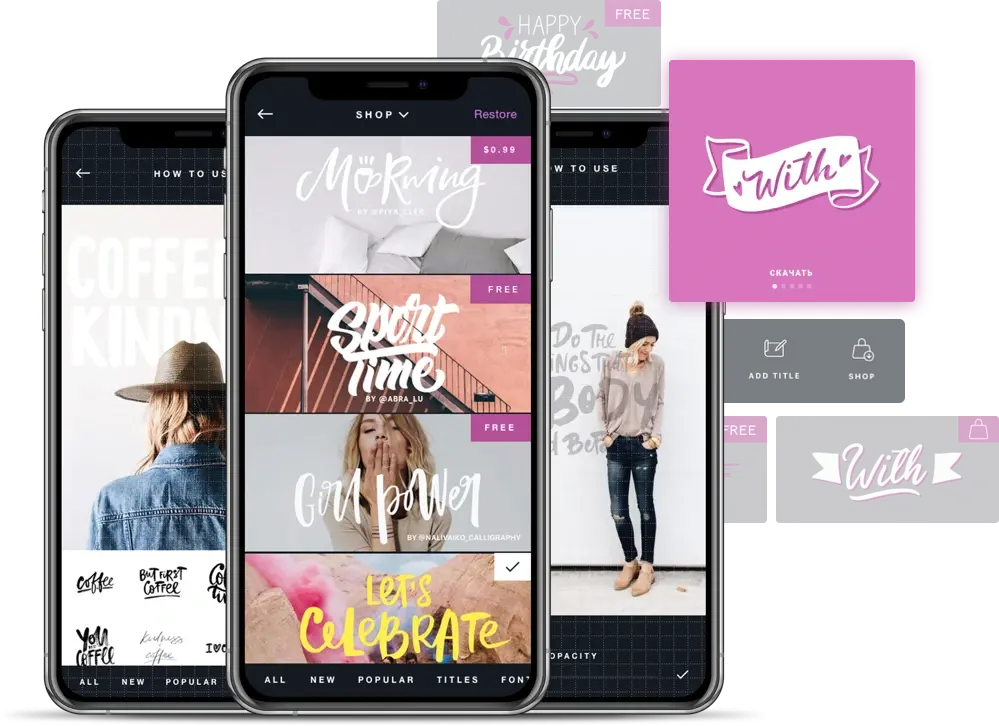Flutter is a robust framework used for building business software compatible with both iOS and Android devices. With a single implementation-agnostic code, it offers high-performance, scalable applications with smart interfaces.
According to Flutter’s product manager, more than 2 million developers have adopted the toolkit since 2018. The recent update also demonstrates significant growth in private and corporate app development using Flutter. With that being said, let’s figure out why exactly Flutter stands out among other similar solutions and why use Flutter.
Flutter Usage Explained
Software development used to require large investments, which was unbearable for low-budget projects. Businesses had to create two independent apps, which obviously meant doing double work. To simplify things, modern frameworks like Flutter enable the creation of hybrid apps to save time, money, and other resources. The cross-platform toolkit has become the common choice in the market.
Flutter’s UI toolkit implements Dart, the client-optimized language intended for creating a smart interface. It serves to build software in desktop, mobile, and web formats based on a single code.
Is Flutter good for app development? Based on the professional experience of our experts, we made up a list of positive and negative aspects of this framework.
Pros:
- Single code for several platforms. No need to write different codes when building solutions for iOS and Android devices. Instead, you get to write and reuse a single code for several platforms, leading to a faster and more affordable app launch.
- Use of widgets. Pre-built widgets can be customized to deliver responsive and visually attractive interfaces. Developers employ those to establish UI elements such as text boxes, buttons and sliders, etc.
- Cost-effective development. Flutter helps cut the cost of creating independent apps for various projects. You also get a range of free resources and tools that lower overhead production costs further.
- Hot reload. This feature enables you to track all code updates in real-time while making essential changes to it. You can debug and test the apps progressively. This advanced capacity can significantly increase productivity and speed up the creative process.
- High safety. Null safety on the syntax level prevents errors enabling unintentional access of variables set to null. The single-threaded UI code is executed in separated sandboxes which involve no shared or unsecured resources.
- Integration of native attributes. You can employ sensors, geographic locations, and camera features to create software with advanced functionality. You can also integrate plugins with independent services like Firebase and Google Maps.
- Excellent documentation and community support. Thorough tutorials, guides, and instructions can help teams of developers throughout the production process. In particular, to identify and troubleshoot any issues they encounter.
Cons:
- Massive apps. Software created with Flutter is heavier, unlike native solutions, which sometimes makes it hard to meet common user needs. The large size can lead to download cancellation.
- Limited expertise. The lack of practical experience may stop specialists from adopting the new framework. So they eventually switch to native development.
- Biased environment. Being a relatively new toolkit, Flutter is struggling to build a wide chain of libraries. The UI toolkit is still in the process of merging with third-party libraries to support software.

What Is Flutter Used for?
Many small and large businesses have picked Flutter to design mobile apps that deliver smooth customer experiences. Experienced brands (Toyota, eBay, Alibaba Group, etc.) and startups (Nubank, Invoice Ninja, Reflectly, etc.) are worth mentioning. They ultimately benefit from the short development cycle and absolute flexibility when building minimum viable products (MVPs) and smart prototypes.
Flutter can be an effective solution for creating single-page (SPA) and progressive web apps (PWAs). It also allows you to convert the existing mobile app into a web and desktop one.
Learn everything you need to know about building a face editing app
Flutter in Numbers
All in all, why use Flutter? What hides behind its moderate success? To give you more reasons, let’s see the data provided by Flutter’s Tim Sneath.
- Over 10% growth in Flutter usage indicated 500,000 specialists using the technology on a monthly basis;
- 39% of developers use Flutter, which is a 9% rise from 2022. The framework is the 2nd most popular choice among new businesses;
- 68.8% of developers deploy Flutter technology for business purposes, based on the report from StackOverflow;
- 400,000 applications have been launched since Flutter’s official release.
Main Cases of Flutter Use
Flutter technology focuses on building mobile, web, and desktop software with a single codebase. However, its functionality expands into other spheres as well, including:
- Single- or multi-page applications. The framework enables the creation of interactive web software. The easy-to-navigate display features a convenient design pattern that enables a page reload every time the content changes.
- Desktop application. Flutter allows specialists to create desktop apps for Windows, macOS, and Linux. Regardless of the format, it delivers native-like experiences.
- Cross-platform mobile application. Flutter helps build high-quality, aesthetic, and high-performing mobile software for iOS and Android. Based on a single codebase, designers can introduce apps that happen to be native to different devices.
- Progressive Web Applications (PWAs). These are web apps that grant native-like experiences when installed on a user’s device. By leveraging Flutter’s powers, developers can create PWAs with high efficiency, offline maintenance, and functional flexibility.
- Basic 2D gaming content. The framework’s engine produces simple 2D games and interactive experiences. Their visual effects and UI capabilities are suitable for creating entertainment content and adding gamified elements to apps.
- Prototyping and MVP. Flutter’s quick development cycle, hot reload feature, and adjustable widgets make it a perfect option for prototyping and Minimum Viable Product (MVP) organization. It allows engineers to test and validate various ideas and acquire independent reviews.
- IoT and embedded systems. The framework can be used to create convenient interfaces for IoT devices and computerized systems. These products can be connected to networks to perform particular functions.

Why Use Flutter over React Native?
Two of the most common cross-platform development technologies include Flutter and React Native. Both of them boast an interactive design, code simplicity, etc. However, Flutter works best for hybrid software, being independent of third-party resources. React Native is a good fit for high-end apps with larger budgets.
To be more specific, take a look at the striking benefits Flutter offers over the closest opponent:
- It has plugins for most operating systems, while React Native has limited coverage.
- It offers a rich library of UI elements, while the opponent focuses on independent tools for UI rendering on particular devices.
- It offers an effective layout mechanism to render widgets, while React Native relies on Flexbox syntax for creating UI design.
- It promises high performance in the short tune, while React Native fails to deliver a fast result.
- It facilitates automation in app development, while React Native forces specialists to go through the process manually.
- It gives comprehensive support to various testing methods, while React Native accepts unit tests only.
Considering the above differences, Flutter offers a more compact app development process. It helps to build lightweight software in a shorter time and at a higher technical level.
AppForType Mobile App

Who Uses Flutter?
Small and large companies have been using Flutter since September 2017. Our experts also use the framework in production due to the numerous advantages and exceptional features it brings to the table. The fast development cycle and the smooth hot reload functionality take the creative process to a totally new level.
Flutter is used by freelance engineers and startups as well as massive corporations. Several teams also deploy it within Google for creating mobile software. Some famous names that utilize the UI toolkit include but are not limited to Alibaba, eBay, and Square.
These days, Flutter has gained the reputation of being reliable and competent enough to compete with the established app development SDKs. Based on our professional experience from the past couple of years, we can confidently say that Flutter has become the most common software framework for businesses and engineers alike. So there are more and more cases where Flutter showcases a definitive advantage.
As the framework continues to grow, we expect even more corporate clients to embrace its creative power for digital experiences. Here are some of the most prominent examples:

eBay Motors
One of the biggest marketplaces to buy and sell motor vehicles and related accessories. Prioritizing user-friendliness, it allows individuals to contact resellers via chat, create new listings, and save search requests. It also features the Escrow payment system. Thanks to Flutter, eBay Motors offers excellent UX, flawlessly combining different elements of complex business logic.
Google Ads
Google's advertising network allows to display ads to an international audience through the Google search engine and other Google venues with a pay-per-click format. Numerous targeting options allow businesses to set campaigns for desired audiences and create intuitive UI to check online performance. Flutter has enabled smooth operations through better insights and faster ad alerts.
Google Pay
Google Pay is a well-known digital wallet that has significantly boosted the adoption of digital payments worldwide. Creating separate solutions for iOS and Android turned out to be a waste of resources, so Google referred to the modern UI toolkit. Eventually, the framework saves the time required to design the app for several platforms by 60-70%.
MyBMW
MyBMW allows drivers to keep their cars under control via smart navigation. Why Flutter? The special automotive app can lock, unlock, and monitor the vehicle through a user-friendly interface. A flawless ownership experience became possible upon saving thousands of hours on development.
Let’s bring your software ideas to reality
Xianyu
The platform offering second-hand products is based on the eCommerce system of Alibaba Group. It requires seamless UX and ultimate marketing features. Flutter became a standard part of Xianyu’s tech mechanics, speeding up development processes and enhancing cross-platform client experiences.
Realtor.com
This realty mobile app has been functioning on two separate lines for Android and iOS devices since 2010. This caused inefficiencies as some problems needed to be resolved twice. Flutter offered a reasonable solution by incorporating the Add-to-App system in the form of a library or module. So it became easier to maintain one codebase in terms of time and finances.
Fuse
An innovative app allows users to split expenses with people they know. It monitors the payments to be made within a certain period of time and charges the money from personal bank accounts when needed. Flutter creates a miracle here. Users can save their bank card details, download their receipts, and handle many other tasks with no extra fees.
Conclusion: Why Use Flutter for Your Next Project
Flutter has more advantages than disadvantages when it comes to designing software for iOS and Android. The high performance, dynamic code writing, and convenient MVP development make the creative process less complex and more resource-efficient. No wonder it has already become a first choice for many, winning over engineers worldwide.
At Requestum, we are ready to help your business become efficient from day one. Our team takes responsibility for creating a modern app with user-friendly functionality. Using the modern framework, we ensure to address your project needs by delivering the best result in the short term.

Our team is dedicated to delivering high-quality services and achieving results that exceed clients' expectations. Let’s discuss how we can help your business succeed.



SHARE: